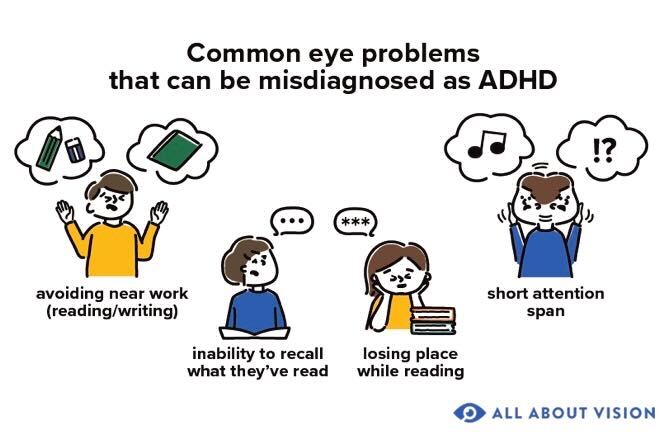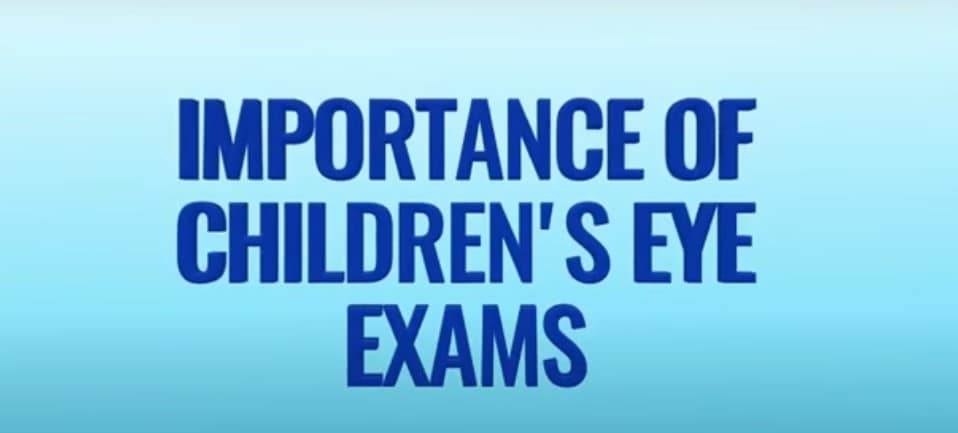Connections between ADHD and vision problems
Symptoms of vision problems and ADHD can overlap, as both may affect focus and attention in children. Understanding the connection and completing the quick assessment below should help you gather information for your doctor so you can get the right diagnosis for your child.
Why are vision issues sometimes misdiagnosed as ADHD?
When a child struggles to see what is happening in class, it may seem like they aren’t paying attention. The same is true for children who frequently lose their place or struggle to recall what they've read. While these signs can indicate attention issues, they may also be a result of functional vision problems.
Teachers and parents might not realize that a child can have vision issues even if they passed a vision screening. That’s because vision screenings don’t catch all vision and eye issues. Vision screenings are just that — screenings. Only a comprehensive eye exam with an eye doctor can ensure a thorough check of your child’s vision and eye health.
Vision problems can sometimes have signs similar to those of ADHD. These can include inattention, fidgeting and trouble focusing. This is how eye-related issues can be misdiagnosed as ADHD.

Additionally, vision problems can worsen existing attention deficits. While the symptoms share some similarities, there are key differences between the two, including:
- Cause – ADHD is a condition that stems from brain function. It affects attention, impulse control and activity. In contrast, vision problems are usually caused by an issue with the eyes or eye movement.
- Symptoms – ADHD symptoms include inattention, hyperactivity and impulsivity. Vision issues mainly cause difficulty with clear distance vision, reading and focusing. These difficulties can contribute to attention issues.
Are children with ADHD at higher risk for certain vision problems?
Researchers have suggested there may be links between ADHD and vision issues. These connections may help explain why kids with ADHD are at higher risk for developing certain vision problems.
Developmental connection
The brain and eyes come from the same tissue in early development. This means that changes in early growth can affect both the nervous system and vision.
Dopaminergic neurons
Dopaminergic neurons are special nerve cells that control dopamine. This chemical messenger is important for attention and behavior. The dopamine pathway is often disrupted in people with ADHD.
Dopamine neurons are also present in the retina, the light-sensitive tissue at the back of the eye. The neurons play important roles in vision, helping you to:
- See colors
- Notice differences in light and dark (contrast sensitivity)
- Adjust to different lighting
- Process where and when things appear in your view
- Regulate the retina’s internal clock (circadian rhythm)
It seems that problems in the dopamine pathways could lead to both ADHD symptoms and issues with visual processing. This overlap may help explain why some children with ADHD are more likely to experience vision problems compared to their peers.
For example:
- Children with ADHD are nearly twice as likely to have vision problems compared to children without ADHD.
- Convergence insufficiency is about three times more common in kids with ADHD. This is when a child’s eyes have difficulty working together to focus on nearby objects.
- Color vision and the ability to judge depth are often impacted in children with ADHD and frequent vision issues.
Does trouble focusing always mean ADHD?
Some children struggle with focusing, staying seated and following directions. While these behaviors can point to ADHD, they could also be signs of undiagnosed vision issues. School vision screenings typically look for issues like nearsightedness and farsightedness. But they may not detect other vision problems, including issues with:
- Eye teaming (how well the eyes work together)
- Focusing (adjusting to see clearly at different distances)
- Tracking (following moving objects or reading across a page)
Overlooked vision issues can make it hard for a child to pay attention and learn in the classroom.
A comprehensive exam by an eye doctor is needed to detect the full range of possible vision problems. If no vision problems are found, or if challenges persist after vision issues are corrected, see an ADHD specialist for further evaluation. It’s important to get the right diagnosis because the treatments for vision problems and ADHD are very different.
Assessment of symptoms
A professional evaluation by an eye doctor is needed for proper diagnosis and treatment of eye issues. Before your appointment, you can use the list of symptoms below to conduct a 60-second assessment of your child. This will help you gather important information to share with your child's doctor.
Signs of vision issues in children
Certain behaviors, difficulties and complaints can indicate that your child has an underlying vision issue. Take note if your child displays any of the following:
Behaviors
If you notice your child displaying any of these actions and habits, it could indicate they have a vision problem:
- Avoidance of near-work tasks
- Academic performance below expectations
- Rushing through homework and other assignments
- Making careless mistakes on schoolwork
- Short attention span
- Zoning out in class or when extended focus is needed
- Forgetting what they have read
- Rubbing their eyes frequently
- Squinting
- Sitting very close to the television
- Holding reading material very close
- Seeming oblivious to distant objects
- Tilting their head or covering or closing one eye to see clearly
Difficulties
Your child may struggle with these specific tasks and skills if they have trouble seeing clearly:
- Keeping track of their place on a page while reading
- Concentrating
- Staying organized
- Following directions
- Sitting still
- Seeing the ball or their teammates while playing sports
- Reading the board at school
Complaints
Your child might complain about the following issues if they have trouble seeing clearly:
- Blurry vision up close (when reading from a book or computer screen)
- Blurry vision at a distance (when reading the board from across the classroom)
- Eye strain and its effects
- Double vision
- Headaches following vision-related tasks
Signs of ADHD in children
Listed below are some behaviors and challenges that children with ADHD may display or experience. Not every child will exhibit all of these signs. Consult an ADHD specialist for further evaluation and proper diagnosis.
Impulsivity/Hyperactivity
These types of actions show that a child may have trouble sitting still or controlling their impulses. Observing your child, you may notice:
- Fidgetiness (frequent movement)
- Impulsive actions
- Problems staying seated
- Difficulty playing quietly
- Excessive talking
- Difficulty waiting their turn
- Blurting out answers too quickly
- Interrupting others
Inattention
These signs show up when a child has difficulty staying focused or paying attention to details. Tasks that require concentration or organization may be especially hard for them. You may observe:
- Difficulty remaining focused
- Poor attention to detail or making careless errors
- Problems prioritizing tasks
- Poor follow-through
- Poor time management
- Avoiding tasks that require sustained mental effort
- Losing personal effects (sports equipment, books, etc.)
- Easily distracted by irrelevant things
Emotional dysregulation
This means a child may struggle to manage their emotions. They may become easily upset or struggle to cope with frustration or negative emotions. Your child may experience:
- Irritability
- Mood swings
- Angry outbursts
- Motivational difficulties
- Problems managing negative emotions (this is more common in adolescents/adults with ADHD)
Potential consequences of a misdiagnosis
Overlapping symptoms can make a diagnosis more complex. A thorough assessment by a professional is critical. In some settings, a child diagnosed with ADHD may face potential stigma from peers or teachers.
A misdiagnosis of ADHD can mean that a child is prescribed medications they don’t need. Side effects of long-term use of ADHD medications can include:
- Changes in appetite
- Weight loss
- Upset stomach
- Shifts in mood
With the correct diagnosis, families and educators can choose the most appropriate learning interventions.
When to contact an eye care professional
If you notice your child having difficulties with vision or attention, it’s essential to act early. Schedule an eye exam so an eye doctor can find any vision issues your child might have.
When to get an ADHD evaluation
If vision problems are found and treated, but focus and attention issues remain, schedule an ADHD evaluation.
To better support your child and their care team:
- Observe your child carefully – Pay close attention to the situations where your child struggles, whether it’s with reading, focusing in class or following instructions.
- Record specific challenges – Keep a log of the behaviors and symptoms you notice. This can include trouble seeing the board, frequent squinting, difficulty staying on task or being easily distracted.
- Review common signs – Compare your observations with typical signs of vision problems and ADHD. Use the symptom assessment above to note which specific challenges your child is facing.
- Get a professional evaluation – Use your notes to share detailed information with qualified health care professionals and educators.
- Communicate with educators – This will help them understand your child’s unique challenges so they can recommend the most appropriate accommodations.
Navigating the uncertainty of ADHD and vision symptoms can feel overwhelming. The first steps are to pay close attention to your child’s challenges and get a professional evaluation. Your doctors can help support you and your child along your journey.







